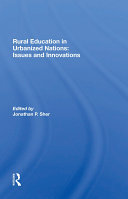
Rural Education In Urbanized Nations: Issues And Innovations PDF
02019·2.834 MB·English
Most books are stored in the elastic cloud where traffic is expensive. For this reason, we have a limit on daily download.
Preview Rural Education In Urbanized Nations: Issues And Innovations
Description:
A reversal in rural-to-urban migration patterns is creating increasing interest in the quality of education in rural areas and in techniques for meeting educational needs in sparsely populated regions. Wholesale urbanization of rural schools generally is rejected as a potential solution: it is logistically inefficient; centralization and standardization are met with growing resistance; and conventional solutions to educational problems produce uneven results when applied to rural areas. This book addresses the broad spectrum of rural education issues within OECD member countries. The authors identify innovative programs, policies, and strategies and point toward the more promising paths for rural school improvement. They also issue warnings about some of the blind alleys and dead ends that can be encountered. The major topics covered include delivery systems, in-school innovations, support mechanisms, and community-school linkages.
See more
The list of books you might like
Most books are stored in the elastic cloud where traffic is expensive. For this reason, we have a limit on daily download.
